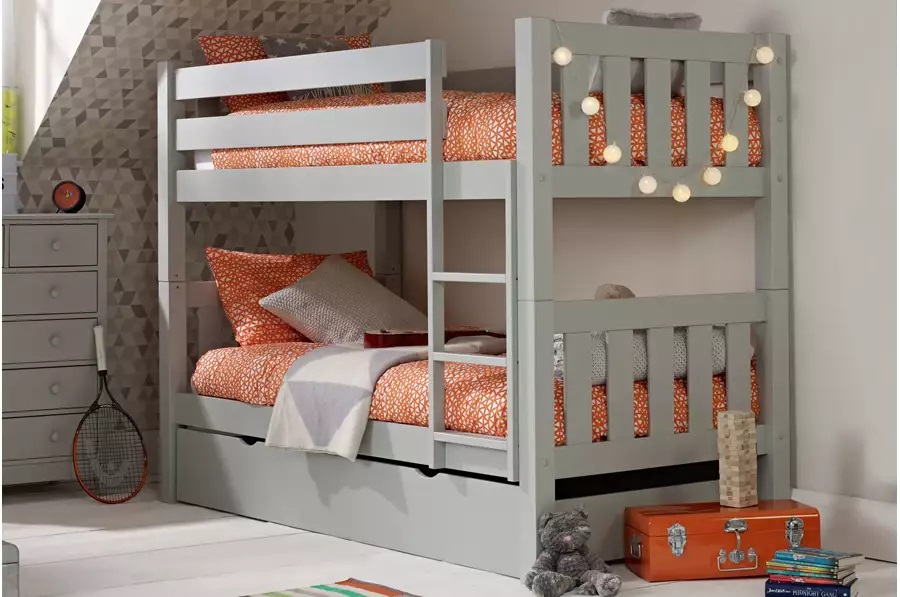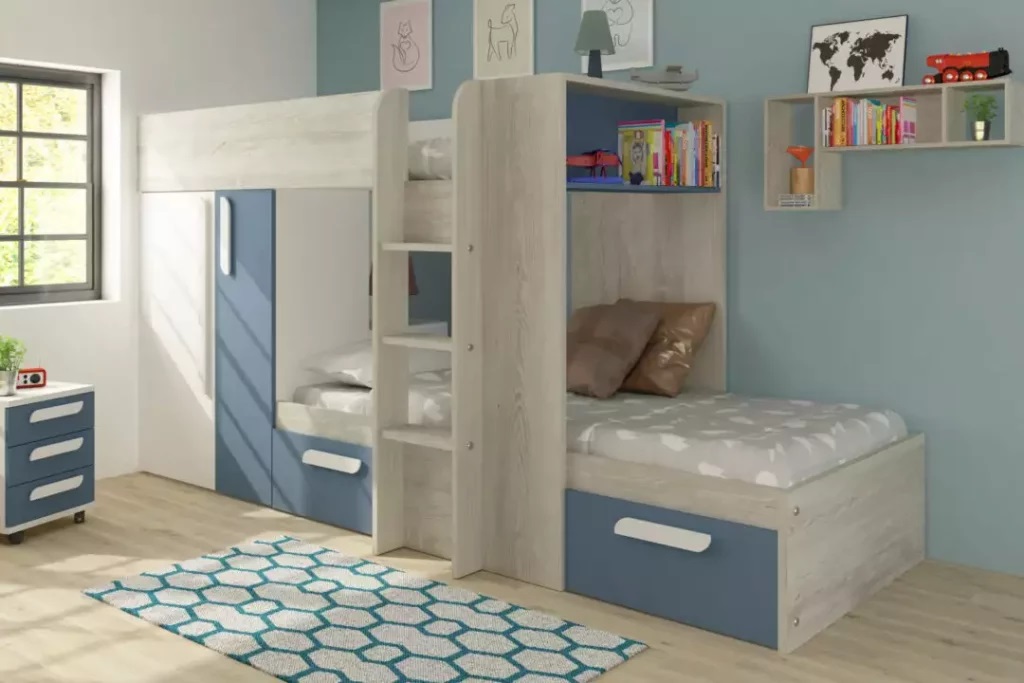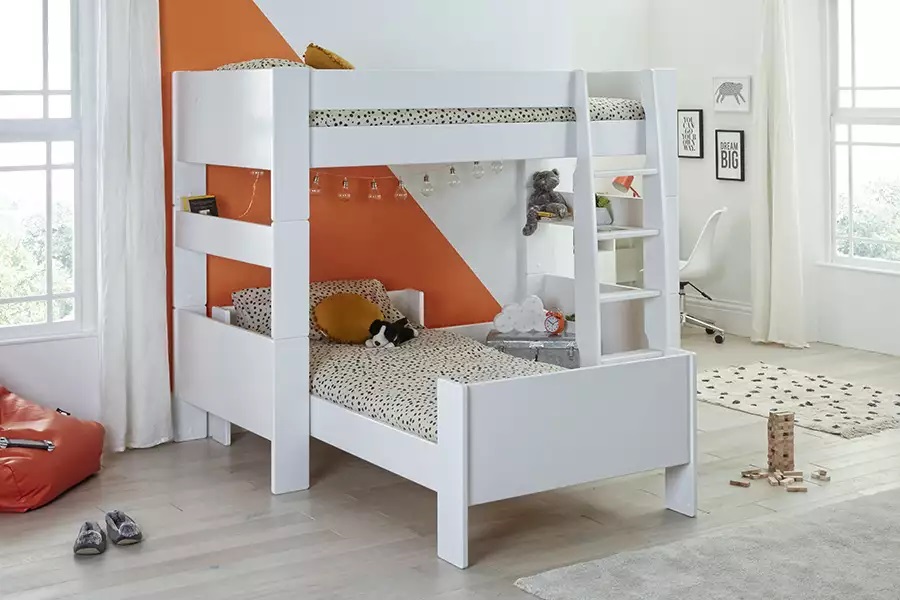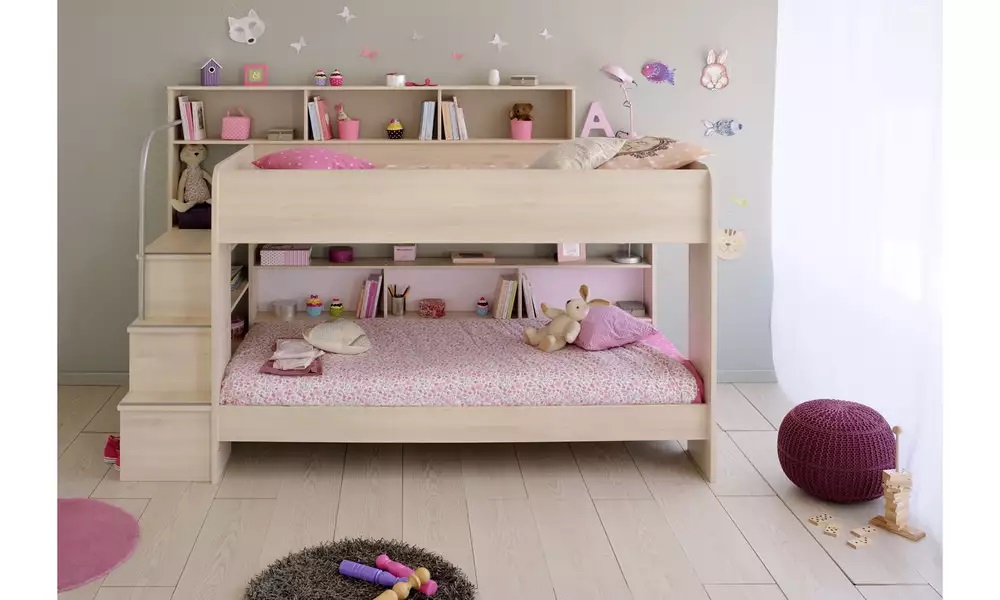Kids Bunk Bed Safety
It is pretty fair to say that ‘Kids love bunk beds’! The excitement of climbing a ladder to bed and sleeping up high, being able to share a room with a sibling or having a friend to stay for a sleepover. There is just something very appealing about having one bed stacked upon another bed!
As a parent, there are all sorts of concerns when it comes to letting your child or children have a bunk bed. The most important questions asked are about safe bunk beds and what to look out for when considering a bunk bed for your children.
Are bunk beds safe?
There are several factors to take into account when it comes to bunk bed safety. There are stringent tests that a bunk bed has to pass to adhere to safety guidelines. It is important that you make sure the bed your chosen bunk bed has been tested to the correct safety standards. Your bunk needs to be tested to EN747 which covers all the key criteria for bunk bed safety, strength and durability requirements.
The main feature of bunk beds is for 2 beds to be stacked one above the other, with the top bunk bed designed with a bunk bed safety rail surrounding the top bunk to prevent your child from falling out of bed. Legally, there must be 16cm from the top of the guard rail to the top of the mattress to prevent your child from rolling out of bed. The gap for the ladder opening must be on the long side of the bed and not at the end of the bed. If the ladder is at the end of the bed, the guard rail must also continue.
How old for bunk beds?
When it comes to the age for bunk beds, the recommended age for the top bunk is 6 years old. This is the bunk bed age law and has been set at age 6 for several reasons. It is important your child is old enough to be able to navigate the ladder to the top bunk. It is also to ensure that your child is able to fully understand safety rules whilst on the top bunk, i.e no jumping on the bunk, no jumping off the bunk bed, no sitting on the guard rail, no swinging from the bunk bed.
When it comes to a maximum age for bunk beds there is no hard or fast rule. It is up to your discretion but consider the size of your child. Are they too tall to sit up in the top bunk without banging their head on the ceiling? Their weight, the top bunk is tested to approximately 80 kilos, if your child is heavier then there will be extra strain on the structure of the bunk bed, the ladder and the slats and it will not be able to withstand the extra weight over time. Bunk beds are designed for children so older teens may be better with a more adult style bed. The bunk bed weight limit will vary from manufacturer to manufacturer so always check if you want the bunk bed for older children.
Weight limit for bunk beds?
As bunk beds are designed for children they are tested to approximately 80 kilos. It will vary from manufacturer to manufacturer and some may test up to 100 kilos. If you are concerned about the weight on the top bunk it is always best to check with the retailer.
Types of bunk bed
When we think of a bunk bed, we naturally picture two beds, one stacked above the other. However, there are different types of bunk bed which you should also consider.
Traditonal bunk bed
Traditional bunk bed – with one bunk above the other. Something to check for safety and comfort is the space between the bunks. Is there enough room for the child on the lower bunk to sit up without hitting their head on the underneath of the top bunk? Is there room for an adult to sit on the bottom bunk and read to your child comfortably?
The bunk bed height may need to be considered if you have low ceilings. It is often a trade off between the overall bunk bed height and the space between the bunks. If your main criteria is to have low height bunk beds then quite often the bottom bunk will sit on the floor or the space between the bunks is reduced in order to keep the overall height of the bunk bed to a minimum.
Offset bunk bed
Offset Bunk Bed – an offset bunk is a great idea when the child on the lower bunk needs more headroom. The offset nature allows more space for the lower bunk so sitting up in bed does not become a factor and the overall height of the bunk can be lower, giving peace of mind to parents concerned about the child on the top bunk.
L - Shaped bunk bed
L-shaped bunk bed - again, the L shape bunk bed gives more under bed space to the child on the lower bunk, allowing room to sit up comfortably in bed. This type of bunk is great for larger bedrooms which don’t have the limitation of floor space which is usually found with a traditional bunk.
Detachable bunk bed - A great feature of a detachable bunk is that the bunk bed can be split into 2 separate beds at any point in the future when a bunk is no longer required. Quite often traditional. Offset or L-shaped bunks can also be detachable bunk beds.
Bunk bed with Stairs
Bunk Bed with stairs - Rather than a ladder, there are bunk beds with steps to the side of the bed. This may be a good option if you are concerned about your child climbing a ladder, particularly during the night-time. Stairs are easier and safer to climb but remember the extra space required in the bedroom to accommodate the bunk bed steps. They’re often a great way to incorporate extra storage where there’s limited space in the bedroom too.
Safety features of a bunk bed
When considering a bunk bed, here are some safety features to take into account;
To stop your child rolling out of the top bunk make sure you have a mattress that is the right depth. There must be 16cm from the top of the mattress to the top of the bunk bed guard rail. It is often recommended that you have a mattress that is 15cm deep to fit safely into the bed frame for your top bunk mattress. The best bunk bed mattress is one designed specifically for bunk beds.
Integrated shelving or clip on shelves are ideal to let your child keep their belongings close by them at night, such as a book, drink, clock so they have them to hand. It is important to consider where your child will keep night time essentials as once they are in the top bunk you don’t want to be cluttering up their sleep space.
A clip on light gives the top bunk easy access to a light in the night-time so your child doesn’t have to climb up and down the ladder in the dark. These lights secure easily to the bunk bed guard rail and have an easy accessible switch to turn the light on and off.
Hand rails or cut out hand holes in the ladder frame are an extra feature some bunk beds offer to make climbing the ladder easier, along with ladder step treads which give extra grip on the steps when climbing.
Another consideration for safety is, how to make a bunk bed?
It can be more difficult to change the bedding of a bunk bed and for an adult negotiating the ladder and top bed whilst trying to change the bedding is certainly a take to consider. First, remove the duvet and pillows so these can be changed at ground level. When it comes to the fitted sheet, this is a little more tricky but by crawling onto the top bunk and tucking one corner at a time this can be achieved. By far the best way to change the bedding is to teach your child to help with this task. They are smaller and more agile and by making it fun it won’t seem like a chore!
If you are building the bunk bed yourself for your children, make sure you follow the assembly instructions meticulously. Make sure the screws are secure but not overtightened so as to crack the wood. Once your bunk bed is assembled there should be no creaking and no rocking of the bed. It should be stable and secure and always test the ladder yourself before your child. If you are uncertain about your DIY skills then call in an expert to assemble the bed for you.
Whilst we are discussing safety, one question often asked about is Bunk Beds for toddlers . If you are selecting bunk beds for siblings to share a room and your youngest child is under 6 years old then they will only be able to sleep in the bottom bunk (the recommended age for the top bunk is 6 years old). If you are concerned about bunk beds for 3 year olds and your child moving a bigger bed, you can choose a bunk with a bunk bed safety rail or you can purchase a separate bunk bed guard rail that sits under the mattress and easily secures to the bottom bunk.
Bunk bed hazards
The most common bunk bed related incidents are falls, trapped limbs or even strangulation.
Remember to never hang clothing, toys or bag straps on to the bunk bed, these can be a strangulation hazard.
Don’t place the bunk bed near a window, ceiling light or ceiling fan for risk of injury.
Tips:
Finally, bunk beds are a great sleeping solution for two children sharing and most children desire a bunk bed at some point in their childhood. Consider the best type of bunk for your family’s use and remember to always take care when using a bunk bed. Most importantly your child should love their bedroom, creating a happy space for them to grow and develop.
Recent Posts
-
The Ultimate Guide to Mid Sleeper Beds for 8-10 Year Olds
Mid sleeper beds are a fantastic choice for children's bedrooms, especially for those in the 8-10 ag
-
The Evolution of Kids Beds: Trends, Concerns, and Choices
Over the past decade, the world of children's beds has undergone significant change. Parents ar












